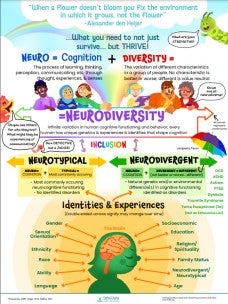
Neurodiversity Equity in FCPS
Affirming the neurodiversity of all students
Introduction
At Fairfax County Public Schools (FCPS), we affirm the neurodiversity of all students through promoting positive self-concept, leveraging and nurturing strengths, and universally designing learning environments that center students’ lived experiences, abilities, and identities. Every individual is neurodiverse from one another as we all think, behave, feel, perceive, communicate, self-regulate, and learn in different ways due to our unique biological makeup, experiences, and identities. All of these different ways of being are value neutral, meaning that there is not one ‘correct’ or ‘right’ way of functioning.
FCPS is committed to a strengths-based approach, centering human variability at the forefront of our decision-making processes and design practices so that all students have equitable opportunities and access to a quality education. This includes removing or minimizing barriers, providing scaffolds and supports to meet students’ needs, building mindsets that drive inclusive language and address biases, and promoting spaces of belonging. FCPS believes it is critical to honor and understand different forms of communication, expression, and cognition so that all students and staff feel seen, safe, and heard.
“When a flower doesn’t bloom you fix the environment in which it grows, not the flower.” -Alexander den Heijer
What is neurodiversity, neurodivergent, and neurotypical?

Neurodiversity is the infinite variation in human cognitive functioning (learning, thinking, perception, communicating, feeling, etc.) due to individuals’ unique brain wiring, experiences, and ways of being. Every human on our planet is neurodiverse as we all think, behave, feel, perceive, and learn in different ways that are entirely unique to each individual (Singer, 2017). Neurodiversity is the umbrella term used to signify that all people process information and interact with the world around them in different ways, and includes those with neurological differences from what is neurotypical, known as neurodivergent.
Neurotypical and neurodivergent are identities and non-medical terms to represent different types of human neurocognitive function. Just as with any other identity within the diversity of human beings, one way of being is not better or worse than another.
Neurotypical means having a style of neurocognitive functioning that falls within the dominant societal standards of what is perceived to be normal or most commonly occurring.
Neurodivergent means having a style of neurocognitive function that diverges from what is considered typical. Neurodivergences are natural genetic and/or environmentally driven differences in neurocognitive functioning, and manifest differently in human beings due to the continuum of experiences. Individuals may process information, communicate, and/or experience the world differently than what is neurotypical. According to the National Institutes of Health (NIH), an estimated 15-20% of the world’s population exhibits some form of neurodivergence (Division of Cancer Epidemiology & Genetics, 2022; Doyle, 2020). Neurodivergences are represented through medical conditions or diagnosis, can exist when a condition or diagnosis has not been identified, and may have one or multiple. A few examples of neurodivergences are Autism, dyslexia, ADHD, Generalized Anxiety Disorder, PTSD, and more.
The neurodiversity paradigm and disability movement both play critical roles in advocating for and advancing social justice efforts for individuals who have been marginalized. A person with a disability is defined by the Americans with Disabilities Act (ADA) as, “an individual who has a physical or mental impairment that substantially limits one or more major life activities, a person who has a history or record of such an impairment, or a person who is perceived by others as having such an impairment.”
It is critical that all students have access to Tier 1 instruction, which includes evidence-based high quality core instruction and differentiated instruction with additional supports as needed, to access the general education curriculum.
If a neurodivergent student has been identified as having a disability, they may require accommodations, and/or specially designed instruction, and/or related services through special education services or Section 504 to remove barriers and access their general education.
“The barrier is in the environment, not the learner.” (CAST, 2022)
Alignment to the Strategic Plan and Educational Equity Policy
The neurodiversity equity work aligns to the FCPS Strategic Plan 2023-30 four pillars of differentiated and culturally responsive learning environments; vibrant home, school, and community partnerships; diverse, adaptive, and supported workforce; and a culture of equity, excellence, and accountability. Additionally, this work supports the FCPS Strategic Plan’s goals and equity commitments.
The FCPS Equity Policy centers students’ strengths and needs and elevates urgency for those students who have been underserved.
FCPS, Equity, and Cultural Responsiveness
The Equity Office is committed to fostering a responsive, caring, and inclusive culture where all feel valued, supported, and inspired to thrive within FCPS. Leading the charge is the Equity and Cultural Responsiveness (ECR) Team, which includes the Neurodiversity Specialist. The ECR Team actively challenges deficit narratives and status quo in order to transform beliefs, practices, and systems that sustain inequities. Their role includes supporting the implementation of the Strategic Plan and Equity Commitments, as well as facilitating the creation of educational environments that meet the diverse needs of students, staff, and families. This team:
- Supports division-wide capacity building and learning.
- Works with schools and departments to make sure all FCPS employees have the knowledge, skills, dispositions, and tools needed to demonstrate cultural responsiveness when supporting students, staff, and families.
- Supports region leadership, coaches, and principals.
- Serves on system-wide collaborative teams.
- Provides direct learning support for both instructional and operational employees.
This website will function as a living document as the work evolves and is responsive to our students, staff, community. As a collective unit, various departments, offices, and schools across our division will engage in the shared responsibility of developing, implementing, and sustaining neurodiversity-affirming practices for students and staff.